

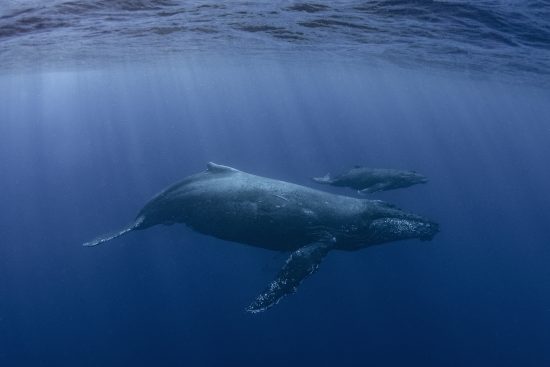
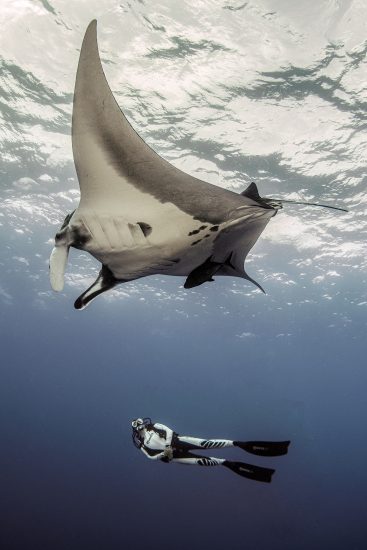
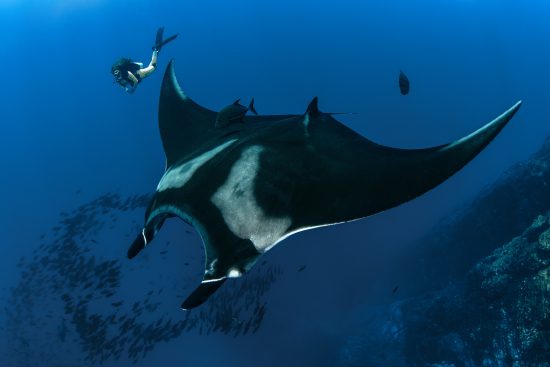

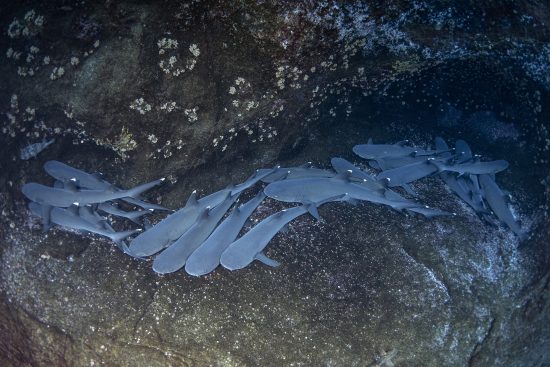

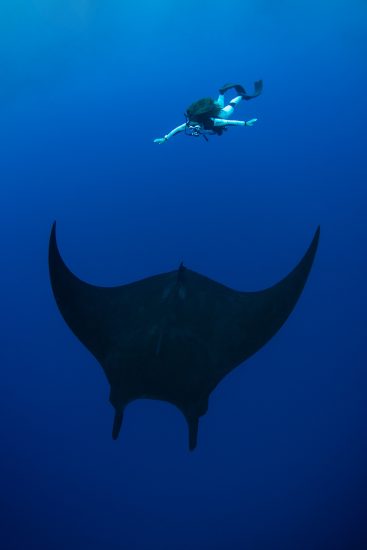
I believe that most divers have a list of destinations they would like to visit and dive at. Socorro is one of the places on my list. Our diving trip through Mexico began before Socorro, in the cenotes near Tulum, after which we headed toward La Paz to enjoy the company of playful seals, with a one-day trip to Cabo Pulmo national park where we had the opportunity to dive with bull sharks. The next two days we spent resting in Cabo San Lucas before boarding the ship “Quino El Guardian” and setting off to a ten-day journey towards the Revillagigedo archipelago and Socorro.
The Revillagigedo archipelago consists of four islands: San Benedicto, Socorro, Roca Partida and Clarion. Socorro, a volcanic island and the biggest of the four, is located around 40 miles south of San Benedicto and 75 miles east of Roca Partida. It is also 600 km west of the Banderas Bay and Puerto Vallart.
After a brief introduction with the crew of “Quino El Guardian” and to the ship itself, our new adventure began almost 600 km away from the mainland.
“Quino El Guardian” is one of seven ships that sail to Socorro. At first glance, it doesn’t seem like much, but its crew, together with an excellent chef and dive guides, more than make up for the appearance of the ship. The rooms are small and simple: 4 beds, 2 up and 2 down, an air conditioning unit in the middle, 4 drawers and a trash bin. Every bed has its own curtain, to provide cover from light and draft, a small night lamp and a smoke detector.
SAN BENEDICTO
It took us almost 30 hours to reach the first island of the archipelago. We arrived at San Benedicto at 4 am and anchored in a cove at the base of a volcano, scared by lava that left behind a stunning scene, especially when seen from the air. An hour later, we were already planning our first diving day. As soon as the first rays of sunlight hit the surface of the ocean, we were already underwater. The water temperature was a comfortable 26ºC with a visibility of 15 – 20 meters.
From the very first moment, the dives were so packed with action that it was nearly impossible to remember and take notes of all the wonderful things going on around us. Drowsy sharks, manta rays, shoals of fish, lobsters...you name it, it was there. Lobsters were so abundant that the loud sound of them tapping the rocks, or each other, often surprised me, but I would always take a moment to get closer and have a quick chat with them. On one occasion, I went closer to a few trench-like crevasses facing the bottom. I looked up and they were crawling with lobsters, easily more than twenty of them. After about 30 minutes of diving, you don’t even notice the sharks anymore. They are constantly circling around out of curiosity and keeping an eye on you from a safe distance. The underwater crowd could be compared to a traffic jam, and looking at all those shoals of jackfish, yellowtails, sharks, manta rays and other fish, I could not help but wonder. how do they all find their way through without any traffic lights? However, after a while, I realized there is one simple but effective rule: the bigger you are, the greater your right to passage is, and if you don’t pay attention, you become an easy snack. No traffic tickets, alcohol tests, turn signals, annoying horns or warnings, all mistakes are payed for immediately and permanently.
SOCORRO
After two days of diving at San Benedicto, we set sail during the night towards our next destination, Socorro, where we arrived early the next day.
It is home to many rare and endemic plants and animals. The ecosystem there is very sensitive and manta and shark populations are extremely valuable. Luckily, the government has recognized the value of this underwater treasure and declared the entire area a marine reserve in 1994.
The highest altitude of Socorro is 1050 meters and the island covers an area of 132 km2. Even though the last volcanic eruption was in 1993, the island is very poorly populated. There is a naval station, founded in 1957, with a population of 250 staff and family members that live in a village at the most southern part of the island, in a small cove with a rocky beach. The station has its own dock, helipad and an airport.
From the very first breaths taken underwater, you get the feeling that the dive will be a spectacular one. Shoals of fish were gathering from all sides, forming an endless curtain, while in the background we could hear dolphins communicating. In a manner of minutes, a small pod of them appeared from the deep and joined our group. Two of them were friendly enough to come and say hello, asking me to pet them by nudging me with their heads. One of them even gave me a hug, I will never forget that incredible moment. A few breaths later,Ii noticed a manta ray above me and I
wondered “Is it sleeping?”. It was completely still. While dolphins never really sleep, they just switch off half of their brain at a time to get some rest, mantas spend most of their day and night sleeping. Allegedly, they are awake for only four hours per day. This giant animal, having a wingspan of up to seven meters and weighing more than a ton, glides almost effortlessly through the deep blue without making a single sound. They can go as deep as 2000 meters and, pound for pound, they have the largest brain of all marine animals. At any given moment, they are watching us, being curious and careful at the same time. At the slightest hint of danger, all it takes is one flap of their wings to disappear out of sight, as if it was never there, as if it was just an apparition.
ROCA PARTIDA
Roca Partida may be the smallest island of the four in the archipelago, but is also the most spectacular one. The island, or the rock, is only about 70 meters long and 25 meters tall. On the surface, it looks like nothing more than a broken tooth, but under water, its walls go down more than 100 meters. It is one of those diving locations where you can dive every day and not get board as
each dive you get to see something different, something new. It is a gathering point for all marine life. Hundreds of sharks, manta rays, yellowfin tuna, humpback whales, whale sharks, lobsters and pipefish visit this place on a regular basis. Our dive guide told us that the seabed around the rock is full of diving gear: lamps, weights, cameras, masks and so on. The currents around the rock
can be quite dangerous and powerful. They can even create whirlpools capable of dragging equipment parts and people into the depths in a manner of seconds, therefore, we agreed that it would be best to stay extra careful during the first dives.
Even though the current was in a good mood during our visit, we still encountered an incredible phenomenon. It felt like being on a carousel, being carried back and forth to the rhythm of some music. Was it trying to make us dance around the rock? It sure felt like dancing a waltz with the sea. Together with the sharks and fish, the current was carrying us in one direction around the rock. I felt empowered, almost superhuman. With just a few strokes of my fins, I could easily swim a hundred meters. On the other hand, every attempt to swim against the current or grasp the rocks was hopeless, even dangerous. Everything became easier once I realized that all you have to do is wait for the next underwater wave and ride it. In fact, it became more then easy, it became fun.
In the crevices of the massive rock, descending to 100 meters, every morning you find packs of sharks. Such an interesting sight. Laying completely still, caught in their sleep, as if they were in a frozen aquarium. I observed their calm line, from the tip of their open mouths to the ends of their tails. Their eyes were open yet they were asleep. We looked into each other’s eyes. Who would blink first? They were in groups of two, three, up to a dozen, laying beside each other, on top of each other, condensed in a grey blue mass, like sardines in a can. At one moment, while gliding through the rocks, I turned around and saw a shark coming straight at me with its mouth wide open. Being around hundreds of sharks in the past few days and experiencing absolutely no
aggression from any of them, this took me by surprise and got my heart racing. Luckily, it was a false alarm. The shark peacefully passed by me with its mouth still open. It has probably been spending too much time around mantas, or just had a nasty cramp in its jaw? Who knows?
Leaving the crevices, we had the opportunity to meet another heavyweight of the deep. Out of a mass of scattered fish appeared a giant tuna with a distinct yellow upper fin and blue strips along its body. With such a gloomy face, nobody wanted to be anywhere near it. However, the tuna didn’t seem to care much, it just sailed away like a giant ship without even a twitch of its tail. Being so hydrodynamic, one swing of its tail is probably sufficient to keep it gliding for kilometers.
During a single dive, dozens of incredible, strange and sudden encounters can occur in the sea. Some of them are unfortunately forgotten, and some of them we remember only several days later. After two days of such fulfilling and exciting dives, it was time to go back to the first island we visited, San Benedicto. This time, however, we would be visiting the other side of the island, a location called The Boiler.
The Boiler is where we would have our last dives at the Revillagigedo archipelago, at least for this trip. There were no waves and no currents. There were less sharks then at the previous location, but there were a lot more moray eels, lobsters and manta rays. Giant black mantas that resemble huge flying saucers hovered over the reefs of The Boiler. Everyone was busy with their cameras and you can almost hear their fingers crunching from all the button pressing. The underwater photo session was at its peak: the models were twisting, bending, changing poses, smiling, taking fast breaths. Not really, it’s actually us taking fast breaths after not breathing during the photo so we wouldn’t create any bubbles or move the camera. These moments, with the mantas, would occupy our minds for days to come, observing, analyzing, discovering new details and criticizing ourselves for not doing things differently. What we noticed is that here, every manta has its own entourage. Suckerfish, or remoras, are long fish that hang like giant whiskers from the bottom or the top side of mantas and other larger animals. Evolution has turned their dorsal fin into some kind of a vacuum pump, a wrinkled pad, which they use to stick to any surface they want. When you look more closely, these remoras are lying on their backs, stuck to the manta with their heads, opening their mouths and collecting scraps of food. A funny scene and a crazy position, nature’s ingenuity at its finest.
The last dives at The Boiler were a real treat. They were pleasant and with plenty of marine life to see. When we surfaced from our very last dive, no one was looking forward to getting back to
the boat. I was laying on my back, watching the volcanic island and admiring the diversity of nature’s shapes and forms. The green and overgrown hovering islands of Papua, the serrated volcanic islands of Socorro with unreal patterns, the endless turquoise, sandy beaches of Cuba, deep holes of the Cenotes in the jungles of Mexico, shallow coral reefs with stranded ships in Egypt... the more places you visit, the more complete you feel. A little safer, but still small under the stars.
Divers are strange fish. Amongst people they are indistinguishable, ordinary, not even average. They don’t care about fashion, hair styles or jewelry. However, as soon as they get close to water, a blue spark of lust shines in their eyes. They take off their glasses, bags and coats, tuck in their tummies and disguise themselves as fish. A moment later, they laugh at the lie that man is not made to be underwater. With their eyes encased in masks, enchanted, they start their adventure in a better world.
Returning to the begining of our journey is always difficult, for both the body and spirit. The body, that was used to floating in an underwater Eden, must now be burdened with the trivial dragging of equipment and other luggage, which got even heavier than when we started. We must once again bend our backs on dry land for ordinary reasons, smile politely at customs so we won’t get stopped, put our hands up and lean to the sensors, empty our pockets, remove our belts, shoes and so on. Is that enough or should I go on? Again, we have to spend the entire flight on a crammed plane seat with countless failed attempts to get some sleep, strapping up for turbulence, squeezing our knees against the seat in front, spending hours waiting in airports, and so on. Nevertheless, as soon as we get home, we forget all about the discomfort and start planning our next journey with new challenges!
Text and photos: Damir Zurub
 Damir
Damir 28th September 2020
28th September 2020